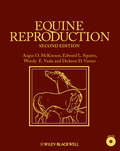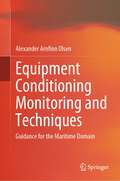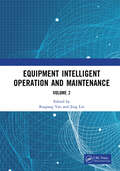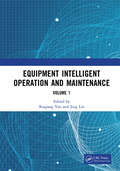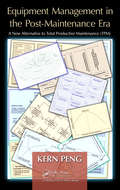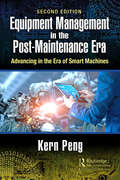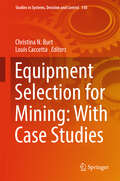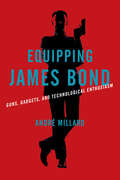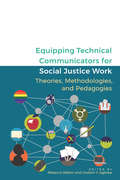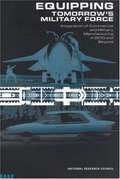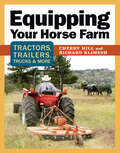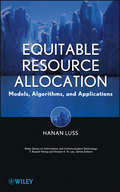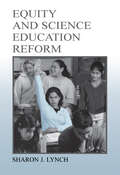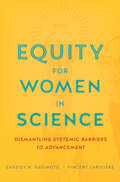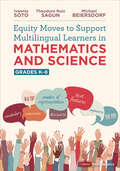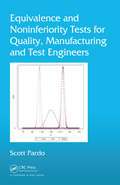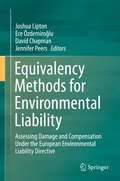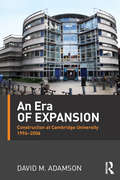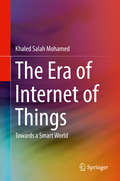- Table View
- List View
Equilibrium Statistical Physics: Phases, Phase Transitions, and Topological Phases
by Marc Baus Carlos F. TejeroThis is a textbook which gradually introduces the student to the statistical mechanical study of the different phases of matter and to the phase transitions between them. Throughout, only simple models of both ordinary and soft matter are used but these are studied in full detail. The subject is developed in a pedagogical manner, starting from the basics, going from the simple ideal systems to the interacting systems, and ending with the more modern topics. The textbook provides the student with a complete overview, intentionally at an introductory level, of the theory of phase transitions. All equations and deductions are included.
Equine Reproduction
by Edward L. Squires Wendy E. Vaala Angus O. Mckinnon Dickson D. VarnerNow in a much-anticipated two-volume new edition, this gold-standard reference stands as the most comprehensive and authoritative text on equine reproduction. Serving theriogenologists, practitioners and breeders worldwide as a one-stop resource for the reproductive assessment and management of equine patients, Equine Reproduction, Second Edition provides detailed information on examination techniques, breeding procedures, pregnancy diagnosis and management, reproductive tract diseases and surgery, and foaling. A companion CD offers hundreds of images from the book in color. For the Second Edition, the stallion, mare and foal sections have been thoroughly updated and revised to include the latest information on every subject. New topics include discussion of nutritional and behavioral factors in the broodmare and stallion, parentage testing, fetal sexing and the health and management of older foals, weanlings and yearlings. Additionally, this outstanding Second Edition features a new section on assisted reproductive techniques, including detailed information on artificial insemination, in-vitro fertilization, embryo transfer and technology.
Equipment and Components in the Oil and Gas Industry Volume 1: Equipment
by Karan SotoodehEquipment and Components in the Oil and Gas Industry Volume 1: Equipment provides an overview of the equipment used in the oil and gas industry, as well as various stages of the oil and gas industry, including geology, exploration, drilling, transportation, and refining. Using practical industry examples and an accessible approach, the book is a key reference point for those seeking to learn more about the industry.The equipment used in the oil and gas industry is wide ranging, from drilling equipment and wellhead equipment, such as casings, tubing, and wellhead Christmas trees, to equipment for the transportation of fluids and gases, such as pumps and compressors. The book presents a simplified method to choose the correct equipment for each task, as well as covering the selection of heat exchangers and storage tanks. Finally, this book covers turbines, motors, and other prime movers, alongside a flare system for disposing of unwanted or waste gases in oil and gas refineries and petrochemical plants.This book will be of interest to mechanical and chemical engineers working in the oil and gas industry.
Equipment and Components in the Oil and Gas Industry Volume 2: Components
by Karan SotoodehEquipment and Components in the Oil and Gas Industry Volume 2: Components provides an overview of the components used in the oil and gas industry, including instrumentation, pipe components, and safety components. Using practical industry examples and an accessible approach, the book is a key reference point for those seeking to learn more about the industry.Covering both larger and smaller components used throughout the oil and gas industry, the book details the theory behind pressure gauges, temperature gauges, flow gauges, and level gauges. It then goes on to discuss piping components, such as pipes, flanges, and gaskets and introduces piping special components. Valves are particularly crucial to the oil and gas industry, including on/off valves, control valves, safety valves, and special valves. The book also details actuators, sprinklers, fire and gas detectors, hoses, and hose reels, along with electrical components such as switches, cables, wires, and cable glands. Finally, the book ends with a discussion of heating, ventilation, and air conditioning (HVAC) components.This book will be of interest to mechanical and chemical engineers working in the oil and gas industry.
Equipment Conditioning Monitoring and Techniques: Guidance for the Maritime Domain
by Alexander Arnfinn OlsenThis book is a single source of guidance and information relating to condition monitoring techniques when designing, implementing and managing a reliability-centred maintenance programme. The topics addressed in this book include a summary of the types of condition-monitoring techniques used by the marine industry, in addition to guidance on the selection of appropriate technique(s), measurement frequency, personnel skills, company resources, and risk assessment. Through the application of condition-monitoring techniques, vessel owners, onshore managers, and marine asset operators should be able to see improved equipment and system reliability onboard their vessels or other marine installations. Moreover, consideration should be given to enrolling vessels and assets in either a reliability-centred maintenance programme or a preventative maintenance programme to take advantage of the additional cost saving benefits for equipment maintenance together with receiving credit towards Class mandated continuous survey for machinery.
Equipment Intelligent Operation and Maintenance: Proceedings of the First International Conference on Equipment Intelligent Operation and Maintenance (ICEIOM 2023), Hefei, China, 21st – 23rd September, 2023 (Volume II)
by Ruqiang YanThe proceedings of the First International Conference on Equipment Intelligent Operation and Maintenance (ICEIOM 2023) offer invaluable insights into the processes that ensure safe and reliable operation of equipment and guarantee the improvement of product life cycles.The book touches upon a wide array of topics including equipment condition monitoring, fault diagnosis, and remaining useful life prediction. With special emphasis on the integration of big data and machine learning, the papers contained in this publication highlight how these technologies make the equipment operation process highly automated and ingenious. Intelligent operation and maintenance is set to act as the driving force behind a new generation of smart manufacturing and equipment upgradation, and promote demand for intelligent product services and management.This is a highly beneficial guide to students, researchers, working professionals and enthusiasts who wish to stay updated on innovative research contributions and practical applications of state-of-the-art technologies in equipment operation and maintenance.
Equipment Intelligent Operation and Maintenance: Proceedings of the First International Conference on Equipment Intelligent Operation and Maintenance (ICEIOM 2023), Hefei, China, 21st – 23rd September, 2023 (Volume I)
by Ruqiang Yan Jing LinThe proceedings of the First International Conference on Equipment Intelligent Operation and Maintenance (ICEIOM 2023) offer invaluable insights into the processes that ensure safe and reliable operation of equipment and guarantee the improvement of product life cycles.The book touches upon a wide array of topics including equipment condition monitoring, fault diagnosis, and remaining useful life prediction. With special emphasis on the integration of big data and machine learning, the papers contained in this publication highlight how these technologies make the equipment operation process highly automated and ingenious. Intelligent operation and maintenance is set to act as the driving force behind a new generation of smart manufacturing and equipment upgradation, and promote demand for intelligent product services and management.This is a highly beneficial guide to students, researchers, working professionals and enthusiasts who wish to stay updated on innovative research contributions and practical applications of state-of-the-art technologies in equipment operation and maintenance.
Equipment Management in the Post-Maintenance Era: A New Alternative to Total Productive Maintenance (TPM)
by Kern PengRecent advancements in information systems and computer technology have led to developments in equipment and robotic technology that have permanently changed the characteristics of manufacturing equipment. Equipment Management in the Post-Maintenance Era: A New Alternative to Total Productive Maintenance (TPM) introduces a new way of thinking to help high-tech organizations manage an increasingly complex equipment base. It also facilitates the fundamental understanding of equipment management those in traditional industries will need to prepare for the emerging microchip era in equipment. Kern Peng shares insights gained through decades of managing equipment performance. Using a systems model to analyze equipment management, he introduces alternatives in equipment management that are currently gaining momentum in high-tech industries. The book highlights the fundamental internal flaw in maintenance organizational setup, presents new approaches to replace maintenance functional setup, and illustrates a time-tested transformation and implementation process to help transition your organization from the maintenance era to the new post-maintenance era. Breaks down the history of equipment into five phases Provides a clear understanding of equipment management fundamentals Introduces alternatives in equipment management beyond the mainstream principles of maintenance management The book examines maintenance management logistics, including planning and budgeting, training and people development, customer services and management, vendor management, and inventory management. Supplying a comprehensive look at the history of equipment management, it analyzes current maintenance practice and details approaches that can significantly improve the effectiveness and efficiency of your equipment management well into the future.
Equipment Management in the Post-Maintenance Era: Advancing in the Era of Smart Machines
by Kern PengRecent advancements in information systems and computer technology have led to developments in equipment and robotic technology that have permanently changed the characteristics of manufacturing equipment. Equipment Management in the Post-Maintenance Era: Advancing in the Era of Smart Machines introduces a new way of thinking to help high-tech organizations manage an increasingly complex equipment base. It also facilitates the fundamental understanding of equipment management those in traditional industries will need to prepare for the emerging microchip era in equipment. Kern Peng shares insights gained through decades of managing equipment performance. Using a systems model to analyze equipment management, he introduces alternatives in equipment management that are currently gaining momentum in high-tech industries. The book highlights the fundamental internal flaw in maintenance organizational setup, presents new approaches to replace maintenance functional setup, and illustrates a time-tested transformation and implementation process to help transition your organization from the maintenance era to the new post-maintenance era. Fundamentally, it: Breaks down the history of equipment into five phases, Provides a clear understanding of equipment management fundamentals, and Introduces alternatives in equipment management beyond the mainstream principles of maintenance management. More specifically, the book examines maintenance management logistics, including planning and budgeting; training and people development; customer services and management; vendor management; and inventory management. Supplying a comprehensive look at the history of equipment management, it analyzes current maintenance practice and details approaches that can significantly improve the effectiveness and efficiency of your equipment management well into the future. This second edition addresses the role of the development of the Internet of Things (IoT) and significant advancements in artificial intelligence (AI) and machine learning (ML) in enabling a new generation of smart machines, which have in turn laid the foundation for Industry 4.0. Equipment utilizing IoT and sensors can monitor components and allow them to be serviced at an exact time without the need for a preventive maintenance schedule. Moreover, equipment replacement rarely occurs at the end of the piece of equipment’s natural life; rather, replacement is driven by the introduction of new technologies and products, all of which lead to less maintenance activities and reduces the importance of the traditional maintenance function. Maintenance departments today operate with fewer employees and smaller budgets. At a point when machines are smart enough to keep themselves running or equipment is rendered obsolete by better equipment in a short time, such as with computers and cellphones, companies do not need a maintenance department. This updated edition reiterates the importance of transitioning to the post-maintenance era to effectively manage today’s sophisticated, smart yet expensive equipment. Many changes the author predicted a decade ago are accelerating in the IoT era. Equipment management is moving further away from the maintenance era and advancing deeper into the post-maintenance era. The trend for smart machines is very clear and companies that do not upgrade their equipment will lose their competitiveness. As equipment and factories become smarter, companies must change their practices and organizational structures to manage the new generation of equipment for Industry 4.0.
Equipment Selection for Mining: With Case Studies (Studies in Systems, Decision and Control #150)
by Louis Caccetta Christina N. BurtThis unique book presents innovative and state-of-the-art computational models for determining the optimal truck–loader selection and allocation strategy for use in large and complex mining operations. The authors provide comprehensive information on the methodology that has been developed over the past 50 years, from the early ad hoc spreadsheet approaches to today’s highly sophisticated and accurate mathematical-based computational models. The authors’ approach is motivated and illustrated by real case studies provided by our industry collaborators. The book is intended for a broad audience, ranging from mathematicians with an interest in industrial applications to mining engineers who wish to utilize the most accurate, efficient, versatile and robust computational models in order to refine their equipment selection and allocation strategy. As materials handling costs represent a significant component of total costs for mining operations, applying the optimization methodology developed here can substantially improve their competitiveness
Equipping James Bond: Guns, Gadgets, and Technological Enthusiasm
by André MillardJames Bond’s amazing gadgets reveal both enthusiasm about technology and fear of its potential ramifications.The popularity of the 007 franchise depends on a seductive formula of sex, violence, and snobbery. Much of its appeal, too, lies in its gadgets: slick, somewhat improbable technological devices that give everyone’s favorite secret agent the edge over his adversaries. In Equipping James Bond, André Millard chronicles a hundred-year history of espionage technology through the lens of Ian Fleming’s infamous character and his ingenious spyware. Beginning with the creation of MI6, the British secret service, Millard traces the development of espionage technology from the advanced weaponry of the nineteenth century to the evolving threat of computer hacking and surveillance. Arguing that the gadgets in the books and films articulate the leading edge of technological awareness at the time, Millard describes how Bond goes from protecting 1950s England from criminal activity to saving a world threatened by nuclear bombs, poison gas, and attacks from space. As a modern and modernizing hero, Bond has to keep up with the times. His film franchise is committed to equipping both Bond and his adversaries with the latest technological gadgets. Simultaneously, Millard stresses, the villains and threats that Bond faces embody contemporary fears about the downside of technological change. Taking a wide-ranging look at factual (and fictional) technology, Millard views the James Bond universe as evidence for popular perceptions of technological development as both inevitably progressive and apocalyptically threatening.
Equipping Technical Communicators for Social Justice Work: Theories, Methodologies, and Pedagogies
by Rebecca Walton Godwin Y. AgbokaEquipping Technical Communicators for Social Justice Work provides action-focused resources and tools—heuristics, methodologies, and theories—for scholars to enact social justice. These resources support the work of scholars and practitioners in conducting research and teaching classes in socially just ways. Each chapter identifies a tool, highlights its relevance to technical communication, and explains how and why it can prepare technical communication scholars for socially just work. For the field of technical and professional communication to maintain its commitment to this work, how social justice intersects with inclusivity through UX, technological, civic, and legal literacies, as well as through community engagement, must be acknowledged. Equipping Technical Communicators for Social Justice Work will be of significance to established scholar-teachers and graduate students, as well as to newcomers to the field. Contributors: Kehinde Alonge, Alison Cardinal, Erin Brock Carlson, Oriana Gilson, Laura Gonzales, Keith Grant-Davie, Angela Haas, Mark Hannah, Kimberly Harper, Sarah Beth Hopton, Natasha Jones, Isidore Kafui Dorpenyo, Liz Lane, Emily Legg, Nicole Lowman, Kristen Moore, Emma Rose, Fernando Sanchez, Jennifer Sano-Franchini, Adam Strantz, Cana Uluak Itchuaqiyaq, Josephine Walwema, Miriam Williams, Han Yu
Equipping Tomorrow's Military Force: Integration of Commercial and Military Manufacturing in 2010 and Beyond
by National Research CouncilInformation on the Integration of Commercial and Military Manufacturing in 2010 and Beyond
Equipping Your Horse Farm: Tractors, Trailers, Trucks & More
by Cherry Hill Richard KlimeshRunning a horse farm requires acquiring, operating, and maintaining an assortment of heavy machinery. This practical guide shows you how to expertly equip your operation with trucks, trailers, tractors, and more. Learn how to compare models, select machines appropriate to your needs, troubleshoot problems, and work with attachments like loaders, disc harrows, and manure spreaders. Using the right machinery will help you work more efficiently, save you money, and leave you more time to spend with your horses.
Equitable Resource Allocation
by Hanan LussA unique book that specifically addresses equitable resource allocation problems with applications in communication networks, manufacturing, emergency services, and moreResource allocation problems focus on assigning limited resources in an economically beneficial way among competing activities. Solutions to such problems affect people and everyday activities with significant impact on the private and public sectors and on society at large.Using diverse application areas as examples, Equitable Resource Allocation: Models, Algorithms, and Applications provides readers with great insight into a topic that is not widely known in the field. Starting with an overview of the topics covered, the book presents a large variety of resource allocation models with special mathematical structures and provides elegant, efficient algorithms that compute optimal solutions to these models.Authored by one of the leading researchers in the field, Equitable Resource Allocation:Is the only book that provides a comprehensive exposition of equitable resource allocation problemsPresents a collection of resource allocation models with applications in communication networks, transportation, content distribution, manufacturing, emergency services, and moreExhibits practical algorithms for solving a variety of resource allocation modelsUses real-world applications and examples to explain important conceptsIncludes end-of-chapter exercisesBringing together much of the equitable resource allocation research from the past thirty years, this book is a valuable reference for anyone interested in solving diverse optimization problems.
Equity and Science Education Reform
by Sharon J. LynchThis lucid, accessible, thought-provoking discussion of issues related to equity in science education reform is for science educators, including idealists and exacting pragmatists, who are dedicated to exploring what it means to put into practice rallying cries like "science literacy for all," "equity and excellence," and "standards-based reform." Intended as an enjoyable and stimulating read, as opposed to a comprehensive summary of everything ever written about equity in science education, it is a response to the new science education standards and reforms, with their goal of science literacy for all. If this goal is to be taken seriously, the implications are immense. A central purpose of this book is to project and discuss how achieving this goal would affect science education reform and vice versa. The work is research based, using statistics, tables, and figures drawn primarily from NSF reports and other public information documents to provide a foundation for equity concerns. However, these statistics are not the main focus of the book. Rather, they are used to make a case, backed by pertinent research, the literature on best practice, and provocative examples from schools and classrooms. Charts, tables, and graphic organizers provide visual evidence and enhance the arguments presented. Moving from research-based studies to classroom stories, Equity and Science Education Reform encourages readers to think about the complexity of the issues. No easy answers or quick fixes are offered. Researching across "identity" areas and attempting to unite them in a discussion that recognizes both the common elements as well as important distinctions, it provides a comprehensive picture of equity concerns across ethnicity, class, gender, and location. Encompassing a broad literature in science education, reform and policy, and equity issues, it offers an "equity schema" as a unifying concept to guide discussion throughout. This book is based, in part, on a series of nine background papers that were commissioned by the American Association for the Advancement of Science's Project 2061 and the summary document, which was written by the author of this book. But it goes far beyond the original study to provide a consistent, coherent, and lively discussion that vividly illustrates the issues raised by the experiences of teachers and students who are struggling with equity principles in the context of science education reform.
Equity for Women in Science: Dismantling Systemic Barriers to Advancement
by Cassidy R. Sugimoto Vincent LarivièreThe first large-scale empirical analysis of the gender gap in science, showing how the structure of scientific labor and rewards—publications, citations, funding—systematically obstructs women’s career advancement.If current trends continue, women and men will be equally represented in the field of biology in 2069. In physics, math, and engineering, women should not expect to reach parity for more than a century. The gender gap in science and technology is narrowing, but at a decidedly unimpressive pace. And even if parity is achievable, what about equity?Equity for Women in Science, the first large-scale empirical analysis of the global gender gap in science, provides strong evidence that the structures of scientific production and reward impede women’s career advancement. To make their case, Cassidy R. Sugimoto and Vincent Larivière have conducted scientometric analyses using millions of published papers across disciplines. The data show that women are systematically denied the chief currencies of scientific credit: publications and citations. The rising tide of collaboration only exacerbates disparities, with women unlikely to land coveted leadership positions or gain access to global networks. The findings are unequivocal: when published, men are positioned as key contributors and women are relegated to low-visibility technical roles. The intersecting disparities in labor, reward, and resources contribute to cumulative disadvantages for the advancement of women in science.Alongside their eye-opening analyses, Sugimoto and Larivière offer solutions. The data themselves point the way, showing where existing institutions fall short. A fair and equitable research ecosystem is possible, but the scientific community must first disrupt its own pervasive patterns of gatekeeping.
Equity Moves to Support Multilingual Learners in Mathematics and Science, Grades K-8 (Corwin Mathematics Series)
by Ivannia Soto Theodore Sagun Michael BeiersdorfA strengths and assets-based approach to multilingual learner success As the number of multilingual learners (MLLs) in US schools continues to grow, educators need to learn the moves necessary to support the success of these students in mathematics and science. Equity Moves to Support Multilingual Learners in Mathematics and Science, Grades K-8 focuses on the literacy opportunities that MLLs can achieve when language scaffolds are taught alongside rigorous math and science content. It provides a framework teachers can use to develop equity-centered, scaffolded math, science, or STEAM lessons. Readers will find Anchor phenomena that demonstrate issues with lesson design and delivery and highlight areas to include language and content scaffolds Examples for honoring the languages of students, families, and communities Culturally responsive techniques and easy-to-use tables featuring the equity moves Vignettes showcasing the equity move in the classroom setting A focus on four language demands: vocabulary, discourse, multiple modes of representation, and text features With an assets-based approach to what MLLs can do, this book helps teachers unpack the language demands of mathematics and science and encourages reflection of their own practices in scaffolding for language and culture.
Equity Moves to Support Multilingual Learners in Mathematics and Science, Grades K-8 (Corwin Mathematics Series)
by Ivannia Soto Theodore Sagun Michael BeiersdorfA strengths and assets-based approach to multilingual learner success As the number of multilingual learners (MLLs) in US schools continues to grow, educators need to learn the moves necessary to support the success of these students in mathematics and science. Equity Moves to Support Multilingual Learners in Mathematics and Science, Grades K-8 focuses on the literacy opportunities that MLLs can achieve when language scaffolds are taught alongside rigorous math and science content. It provides a framework teachers can use to develop equity-centered, scaffolded math, science, or STEAM lessons. Readers will find Anchor phenomena that demonstrate issues with lesson design and delivery and highlight areas to include language and content scaffolds Examples for honoring the languages of students, families, and communities Culturally responsive techniques and easy-to-use tables featuring the equity moves Vignettes showcasing the equity move in the classroom setting A focus on four language demands: vocabulary, discourse, multiple modes of representation, and text features With an assets-based approach to what MLLs can do, this book helps teachers unpack the language demands of mathematics and science and encourages reflection of their own practices in scaffolding for language and culture.
Equivalence and Noninferiority Tests for Quality, Manufacturing and Test Engineers
by Scott PardoIn engineering and quality control, various situations, including process validation and design verification, require equivalence and noninferiority tests. Equivalence and Noninferiority Tests for Quality, Manufacturing and Test Engineers presents methods for using validation and verification test data to demonstrate equivalence and noninferiority
Equivalency Methods for Environmental Liability
by Joshua Lipton Ece Özdemiroğlu David Chapman Jennifer PeersThe book is the only technical volume that explains how equivalency analysis methods mentioned in Annex II of the European Environmental Liability Directive should be implemented. It uses case studies to illustrate real-world application of the methods, which are based on the experience in the USA and in the European Union and have been tested in three years of training programs funded by the European Commission. Academically rigorous and technically comprehensive, the book is intended for technical experts wanting to assess damage and remediation options as well as for decision-makers wishing to commission such assessments and judge their quality. These include competent authorities, operators, financial security providers, academics, consultants and NGOs.
An Era of Expansion: Construction at the University of Cambridge 1996–2006
by David M. AdamsonChanging conditions in Higher Education and national funding regimes preceded a proliferation of construction projects in universities between 1996 and 2006. This book reviews a hundred projects between 1996 and 2006, and uses 9 detailed case studies from the author's time in charge of capital projects at the University of Cambridge to show us how these projects were conceived, argued for, designed, procured, managed, constructed, and passed on to building users. Readers with an interest in project management, estate management, University management, or the history of the University of Cambridge will find this fascinating and wide-ranging book to be uniquely valuable.
The Era of Internet of Things: Towards a Smart World
by Khaled Salah MohamedThis book introduces readers to all the necessary components and knowledge to start being a vital part of the IoT revolution. The author discusses how to create smart-IoT solutions to help solve a variety of real problems. Coverage includes the most important aspects of IoT architecture, the various applications of IoT, and the enabling technologies for IoT. This book presents key IoT concepts and abstractions, while showcasing real case studies. The discussion also includes an analysis of IoT strengths, weaknesses, opportunities and threats. Readers will benefit from the in-depth introduction to internet of things concepts, along with discussion of IoT algorithms and architectures tradeoffs. Case studies include smart homes, smart agriculture, and smart automotive.
Erase the Waste and Turn Trash Into Cash: Inquiry-Based Science Lessons for Advanced and Gifted Students in Grades 3-4
by Jason S. McIntoshRecipient of the 2021 NAGC Curriculum Award Americans throw away 254 million tons of trash every year, and students are naturally curious about where it all goes. Erase the Waste and Turn Trash Into Cash, a 30-lesson interdisciplinary science unit: Is designed to teach high-ability third and fourth graders how to think like real-world environmental engineers. Requires students to reduce, reuse, recycle, and reimagine trash in new and innovative ways. Was designed using the research-based Integrated Curriculum Model. Features challenging problem-based learning tasks and engaging resources. Includes detailed teacher instructions and suggestions for differentiation. In this unit, students study the concept of innovation and learn to manage and dispose of waste in creative and environmentally friendly ways, all while building an understanding of sustainability, recycling, environmental science, and the green economy. Suggestions and guidance are included on how teachers can adjust the rigor of learning tasks based on students' interests and needs. Grades 3-4
Erased (Altered #2)
by Jennifer RushThey thought they had escaped. They were wrong.After fleeing the Branch with Sam, Cas, and Nick, Anna is learning how to survive in hiding, following Sam's rules: Don't draw attention to yourself. Always carry a weapon. Know your surroundings. Watch your back.When memories from Anna's old life begin to resurface--and a figure from her childhood reappears--Anna's loyalties are tested. Is it a Branch set-up, or could it be the reunion Anna has hoped for? Ultimately, the answers hinge on one question: What was the real reason her memories were erased in the first place?Jennifer Rush delivers a thrilling sequel to Altered in a novel packed with mysteries, lies, and surprises that are sure to keep readers guessing until the last page is turned.

